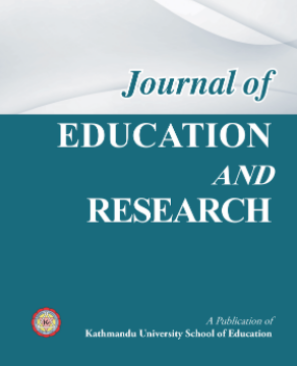
Bridging the Learning Gap by an Innovative Induction Session of an Integrated Basic Science Course for Allied Health Science Students in Nepal
Perspective Article
Journal of Education and Research, Volume 14, Issue 1, 2024, 117-124, https://doi.org/10.51474/jer/16197
Publication date: Mar 27, 2024
Views: 427 | Downloads: 173
How to cite this article
APA
In-text citation: (Bhat, 2024)
Reference: Bhat, N. (2024). Bridging the Learning Gap by an Innovative Induction Session of an Integrated Basic Science Course for Allied Health Science Students in Nepal. Journal of Education and Research, 14(1), 117-124. https://doi.org/10.51474/jer/16197
Reference: Bhat, N. (2024). Bridging the Learning Gap by an Innovative Induction Session of an Integrated Basic Science Course for Allied Health Science Students in Nepal. Journal of Education and Research, 14(1), 117-124. https://doi.org/10.51474/jer/16197
Vancouver
In-text citation: (1), (2), (3), etc.
Reference: Bhat N. Bridging the Learning Gap by an Innovative Induction Session of an Integrated Basic Science Course for Allied Health Science Students in Nepal. Journal of Education and Research. 2024;14(1):117-24. https://doi.org/10.51474/jer/16197
Reference: Bhat N. Bridging the Learning Gap by an Innovative Induction Session of an Integrated Basic Science Course for Allied Health Science Students in Nepal. Journal of Education and Research. 2024;14(1):117-24. https://doi.org/10.51474/jer/16197
AMA
In-text citation: (1), (2), (3), etc.
Reference: Bhat N. Bridging the Learning Gap by an Innovative Induction Session of an Integrated Basic Science Course for Allied Health Science Students in Nepal. Journal of Education and Research. 2024;14(1), 117-124. https://doi.org/10.51474/jer/16197
Reference: Bhat N. Bridging the Learning Gap by an Innovative Induction Session of an Integrated Basic Science Course for Allied Health Science Students in Nepal. Journal of Education and Research. 2024;14(1), 117-124. https://doi.org/10.51474/jer/16197
Chicago
In-text citation: (Bhat, 2024)
Reference: Bhat, Neeti. "Bridging the Learning Gap by an Innovative Induction Session of an Integrated Basic Science Course for Allied Health Science Students in Nepal". Journal of Education and Research 2024 14 no. 1 (2024): 117-124. https://doi.org/10.51474/jer/16197
Reference: Bhat, Neeti. "Bridging the Learning Gap by an Innovative Induction Session of an Integrated Basic Science Course for Allied Health Science Students in Nepal". Journal of Education and Research 2024 14 no. 1 (2024): 117-124. https://doi.org/10.51474/jer/16197
Harvard
In-text citation: (Bhat, 2024)
Reference: Bhat, N. (2024). Bridging the Learning Gap by an Innovative Induction Session of an Integrated Basic Science Course for Allied Health Science Students in Nepal. Journal of Education and Research, 14(1), pp. 117-124. https://doi.org/10.51474/jer/16197
Reference: Bhat, N. (2024). Bridging the Learning Gap by an Innovative Induction Session of an Integrated Basic Science Course for Allied Health Science Students in Nepal. Journal of Education and Research, 14(1), pp. 117-124. https://doi.org/10.51474/jer/16197
MLA
In-text citation: (Bhat, 2024)
Reference: Bhat, Neeti "Bridging the Learning Gap by an Innovative Induction Session of an Integrated Basic Science Course for Allied Health Science Students in Nepal". Journal of Education and Research, vol. 14, no. 1, 2024, pp. 117-124. https://doi.org/10.51474/jer/16197
Reference: Bhat, Neeti "Bridging the Learning Gap by an Innovative Induction Session of an Integrated Basic Science Course for Allied Health Science Students in Nepal". Journal of Education and Research, vol. 14, no. 1, 2024, pp. 117-124. https://doi.org/10.51474/jer/16197
ABSTRACT
At the start of each course, students feel overwhelmed and unprepared. The vastness of content covered in any course of undergraduate school can become daunting. Thus, an inductive buffer session is designed as an “Introduction to disease” at the start of each system-based basic science course so that each student can familiarize themselves with key concepts for better upcoming sessions in a low-resource setting. The session incorporated common case studies and supplemented them with visual or physical materials that the students were already familiar with. When we argue for adopting inductive methods, we do not propose the complete avoidance of didactic lectures and relying solely on self-discovery. Rather, our approach emphasizes wherein induction preempts deduction.
REFERENCES
- Adhikari, B., & Mishra, S. R. (2016). Urgent need for reform in Nepal’s medical education. The Lancet, 388(10061), 2739–2740. https://doi.org/10.1016/S0140-6736(16)32423-0 Ferlazzo, L., & Sypnieski, K. H. (2018). The ELL teacher’s toolbox: Hundreds of practical ideas to support your students. John Wiley & Sons.
- Martínez, F., Montiel, H., & Jacinto, E. (2016). Inductive teaching and problem-based learning as significant training tools in electrical engineering. In V. L. Uskov, R. J. Howlett, & L. C. Jain (Eds.), Smart Education and e-Learning 2016. Springer International Publishing. https://link.springer.com/chapter/10.1007/978-3-319-39690-3_16
- Norton, M. I. (2012). The IKEA effect: When labor leads to love. Harvard Business School. https://www.hbs.edu/faculty/Pages/item.aspx?num=41121
- Orozalieva, G., Loutan, L., Azimova, A., Baroffio, A., Heller, O., Lab, B., Mambetova, A., Mambetalieva, D., Muratalieva, E., Nendaz, M., Savoldelli, G., Vu, N. V., & Beran, D. (2021). Reforms in medical education: Lessons learnt from Kyrgyzstan. Global Health Action, 14(1). https://doi.org/10.1080/16549716.2021.1944480
- Prince, M. J., & Felder, R. M. (2006). Inductive teaching and learning methods: Definitions, comparisons, and research bases. Journal of Engineering Education, 95(2), 123–138. https://doi.org/10.1002/j.2168-9830.2006.tb00884.x
- Vallikat, A. (2021, August 12). Maxims of teaching. Teachmint. https://blog.teachmint.com/maxims-of-teaching/
- Trullàs, J. C., Blay, C., Sarri, E., & Pujol, R. (2022). Effectiveness of problem-based learning methodology in undergraduate medical education: A scoping review. BMC Medical Education, 22(1), 1–12. https://doi.org/10.1186/s12909-022-03154-8
DISCLOSURE
The author declared no potential conflicts of interest with respect to the research, authorship, and publication of this article.
LICENSE
This work is licensed under a Creative Commons Attribution-ShareAlike 4.0 International License.
